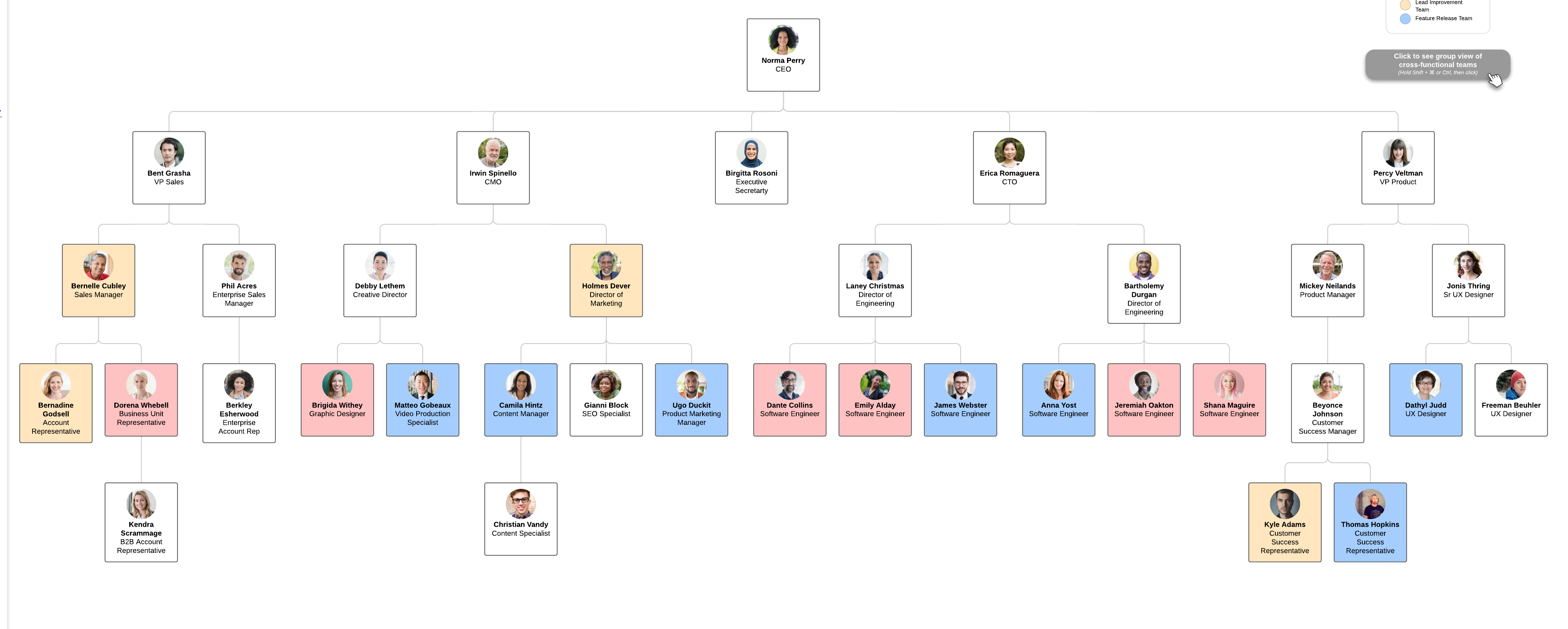
How to get buy-in for changes to your organizational structure
Reading time: about 6 min
Topics:
Imagine you’ve decided to move without informing the rest of your family. And they live with you. It probably wouldn’t go over well (to say the least).
You’re likely to have similar results if you make organizational changes without getting buy-in from key stakeholders in your business. Even if everyone in your company agrees that organizational changes need to happen, it’s still important to gather input and approval from finance, HR, and management/operations so all are on the same page.
Here’s how to get your team behind an organizational redesign.
How to get buy-in from cross-functional leadership
Each member of your leadership team across your organization should be united toward a common goal that’s outlined by your mission statement—but they may have different viewpoints and recognize different needs for their individual departments. To implement an organizational redesign, you’ll need the entire leadership team on board.
Use these strategies to join potentially disparate views in leadership and unite in a common restructuring.
Share the current state of your org
It’s possible that not everyone has a clear understanding of your current organization. Therefore, the very first step to getting buy-in is pulling current information from your HR software or the most accurate source and visualizing that information as an organizational chart.
Org charts are a quick, easily understandable way of conveying the exact organizational structure of your business. At a glance, it’s easy to tell who reports to whom and to which department each person belongs.
But org charts can show more than the standard hierarchy. The current state should also communicate information that directly correlates to the need for a new organizational structure. If you need to, for instance, operate with a skeleton crew to weather a crisis, this exercise helps identify the most crucial roles necessary to keep the lights on.
In Lucidchart, you can speed up the process of defining your current state—automatically generate an org chart and overlay employee data to identify redundancies across teams, identify gaps, and other important insights to optimize your organization’s structure.

Once you have your org chart, use visual cues to highlight gaps or problems. Here are some common issues that may need to be addressed through organizational change:
- Filling skill gaps: If your business is preparing to scale, introduce a new product or service, or take advantage of a new market opportunity, you might require new skill sets. Layer employee capabilities onto your org chart and highlight gaps.
- Automating processes: New technology may necessitate a change in org structure. Add or omit jobs in accordance with changing technology, automation, and AI.
- Planning for mergers and acquisitions: If your business is going through the M&A process, it’s likely that roles will need to be analyzed and altered as needed.
- Preparing for growth: If your business is transitioning from startup to public IPO, it will likely need to scale… and quickly. A deep dive into your org structure helps plan this fast growth.
- Weathering a crisis: In an economic downturn or a similar situation, companies may need to adapt their org structures to keep their business solvent.
- Becoming distributed: Transitioning to a remote or distributed company may result in organizational changes. As you plan, indicate the physical location of people in your organization on your org chart.
Share your new design and what it’s intended to achieve
After establishing the current state of your org, you can share the new organizational design. Make the proposed adjustments to your org chart, and show the current and future states back to back so leadership can clearly see what will be different.

You’re more likely to get buy-in if you have good reason for the proposed changes—and the key is to emphasize the benefits of an organizational redesign. Consider these strategies for communicating your goals.
Focus on the long-term strategy
When you propose your org changes, you need to justify the effort—if the problem can be resolved or the need fulfilled with short-term fixes, you won’t get the buy-in you require.
Present your new organizational structure in the context of a strategy that favors positioning the business in a better light—or the long-term plan your company has already established. Communicate how the organizational structure change will affect the bottom line, help your business stay competitive and relevant, open in a new market, or achieve greater growth. These are the kinds of strategies that unite members of leadership.
Stress accountability
Every organizational redesign is a calculated risk. When you present your changes in organizational structure, show the metrics you’ll be using to measure the success of the redesign.
Be sure to include how you plan to communicate those metrics (email, presentation, etc.) to stakeholders and the business at large. Members of the organization will feel relieved about approving the org change once they see its quantifiable impact.
Share an action plan
Making a bold, audacious organizational change is one thing; implementing it is something else entirely. First, identify obstacles in your redesign path and know how to avoid or overcome them. Be flexible because you might have to adapt the process along the way. If, for instance, it takes some time to fill a particular role, you may need to adjust the requirements for that particular role or start looking outside your preferred geographic area for desired candidates.
Also, make sure to include pragmatic issues like seating and equipment arrangements. If you are proposing to join two teams and these employees aren’t currently sitting closely together, for example, that can impact how well they’re able to function as a team.
How to get employee buy-in
Once you have buy-in from leadership, you still need employee buy-in for organizational change, as these changes will directly affect many team members. Without that pivotal approval and acceptance of the plan, greater friction will arise.
Put employees’ minds at ease by presenting the org changes visually to everyone at once.
To many employees, changes in organizational structureare a time of tremendous uncertainty. They may feel that the business isn’t performing well, that their jobs are at stake, or that they will lose a beloved leader. A presentation—complete with a clear visual and the long-term strategy you offered to leadership—is a great way to calm those fears, show how organizational changes will benefit the employees, and have greater control of the conversation.
When presenting your idea for organizational redesign, you should anticipate issues that may surface among employees and determine how you will quell those issues.
Set up a survey or an email alias where employees can ask anonymous questions and receive answers from leadership. Open up the end of your presentation to questions that can be answered in front of the entire business. With these strategies, you can gather issues you may not have anticipated so that you can pose a resolution before implementing the new organizational structure. This will prepare you to meet potential objections and improve your chances of getting employee buy-in at all levels.
A business is, at its heart, a group of people united toward a common goal. It’s important to not only evaluate how the organizational redesign is performing but also become comfortable with continually measuring its impact for years to come.
Determine how often you’ll measure your restructure and what the parameters of success will look like. In this way, you’ll be able to stay competitive in a changing landscape and be better informed the next time your business needs to reevaluate its org structure.

Explore how Lucidcahrt can help you plan the future of your organization.
See howAbout Lucidchart
Lucidchart, a cloud-based intelligent diagramming application, is a core component of Lucid Software's Visual Collaboration Suite. This intuitive, cloud-based solution empowers teams to collaborate in real-time to build flowcharts, mockups, UML diagrams, customer journey maps, and more. Lucidchart propels teams forward to build the future faster. Lucid is proud to serve top businesses around the world, including customers such as Google, GE, and NBC Universal, and 99% of the Fortune 500. Lucid partners with industry leaders, including Google, Atlassian, and Microsoft. Since its founding, Lucid has received numerous awards for its products, business, and workplace culture. For more information, visit lucidchart.com.
Related articles
All about matrix organizations
Learn all about structuring matrix organizations and how they can benefit your team.
